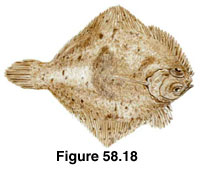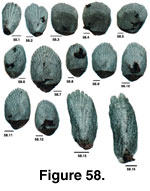 Description
Description
Pleuronichthys coenosus (C-O Sole)
(Other common names: Spotflounder, Popeye Sole, Muddy Flounder)
Figure 58.18
 Description
DescriptionLength: 36 cm.
Mouth: small, terminal; narrow gape; asymmetrical; maxillary extends to below the forepoint of the lower eye; thickened lips; teeth mainly on the blind side of jaws.
Body: caudal peduncle deep; caudal fin rounded; dorsal and anal fins high; the first five to six dorsal rays begin on the blind side; small spine before anal fin; pectorals bluntly pointed; lateral line slightly curved over pectoral region then straight; accessory dorsal branch long.
Color: dark brown to black on the eyed side; creamy white on the blind side; dark spot mid-body on eyed side; similar spot on mid-caudal fin; dark curved bar at the base of the caudal fin (last two features look like a 'C' and an 'O').
Depth: up to 350 m.
Habitat: both soft and hard substrates; eelgrass habitats; young are more common in shallow waters; can adjust colouration to substrate.
Season: Hart (1973) lists hatching of eggs at 13.8ºC after 12 days; suggesting that spawning occurs late spring to summer.
Diet: polychates, molluscs, and crustaceans.
Predators: not determined.
Distribution: Mexico, to Baja, California to Alaska.
 Scale Description
Scale DescriptionScale Type: cycloid on both sides.
Relative Size of Scale: moderate.
Scale Position: imbedded in the skin on the fins (Hart, 1973).
Overall Scale Shape: circular to slightly ovoid.
Focus and Circuli: the focus is not centralized and is approximately one-fourth to one-fifth of the total scale length from the edge of the posterior field. The circuli are discontinuous in all fields (Batts, 1964).
Radii: numbers are variable and not diagnostic. Present in the anterior field and may extend into the anterior edges of the lateral fields (radii not present in all fields, Batts, 1964). The outer edge of the anterior fields is convex and smooth with only a slight scalloping. Intermarkings absent (Batts, 1964).